Ofcet 32 SC
Sailboat specifications
The Ofcet 32 is a 32’2” (9.8m) fast cruising sailboat designed by Marc Lombard Yacht Design Group (France). She was built between 2016 and 2019 by Ofcet (France). The SC version adopts a T-shaped keel delivering good performance/price trade-off.
The Ofcet 32 is as well listed, on Boat-Specs.com, in Standard version (see all the versions compared).
Find out more about the Ofcet 32 on Boat-Spec's blog: New sailboats 2017 - France 1/2.
The Ofcet 32 is as well listed, on Boat-Specs.com, in Standard version (see all the versions compared).
Find out more about the Ofcet 32 on Boat-Spec's blog: New sailboats 2017 - France 1/2.
Ofcet 32's main features
- Model
- Ofcet 32
- Version
- SC
- Hull type
- Monohull
- Category
- Fast cruising sailboat
- Sailboat builder
- Sailboat designer
- Country
- France
- Construction
- GRP (glass reinforced polyester):
- Hull: Sandwich PVC fiberglass (vacuum infusion)
- Deck: Sandwich PVC fiberglass (vacuum infusion) - First built hull
- 2016
- Last built hull
- 2019
- Appendages
- Keel : T-shaped keel (with bulb)
- Helm
- Single tiller
- Rudder
- Twin spade rudders
- Unsinkable
- No
- Trailerable
- No
- EC design categoryiThe CE design category indicates the ability to cope with certain weather conditions (the sailboat is designed for these conditions)
A: Wind < force 9, Waves < 10m
B: Wind < force 8, Waves < 8m
C: Wind < force 6, Waves < 4m
D: Wind < force 4, Waves < 0,5m - A
- Standard public price ex. VAT (indicative only)
- About120 000 €(2017)
Ofcet 32's main dimensions
- Overall length
- 36’ 1”11 m
- Hull length
- 32’ 2”9.8 m
- Waterline length
- 30’ 1”9.18 m
- Beam (width)
- 11’3.36 m
- Draft
- 6’ 5”1.95 m
- Mast height from DWL
- 50’ 6”15.4 m
- Light displacement (MLC)
- 7055 lb3200 kg
- Ballast weight
- 2866 lb1300 kg
- Ballast type
- Cast iron
Ofcet 32's rig and sails
- Upwind sail area
- 624 ft²58 m²
- Downwind sail area
- 1302 ft²121 m²
- Mainsail area
- 334 ft²31 m²
- Genoa area
- 291 ft²27 m²
- Symmetric spinnaker area
- 969 ft²90 m²
- Rigging type
- Sloop Marconi 9/10
- Mast configuration
- Deck stepped mast
- Rotating spars
- No
- Number of levels of spreaders
- 2
- Spreaders angle
- Swept-back
- Spars construction
- Carbon fiber spars
Ofcet 32's performances
- Upwind sail area to displacementiThe ratio sail area to displacement is obtained by dividing the sail area by the boat's displaced volume to the power two-thirds.
The ratio sail area to displacement can be used to compare the relative sail plan of different sailboats no matter what their size.
Upwind: under 18 the ratio indicates a cruise oriented sailboat with limited performances especially in light wind, while over 25 it indicates a fast sailboat. - 288 ft²/T26.71 m²/T
- Downwind sail area to displacementiThe ratio sail area to displacement is obtained by dividing the sail area by the boat's displaced volume to the power two-thirds.
The ratio sail area to displacement can be used to compare the relative sail plan of different sailboats no matter what their size. - 600 ft²/T55.72 m²/T
- Displacement-length ratio (DLR)iThe Displacement Length Ratio (DLR) is a figure that points out the boat's weight compared to its waterline length. The DLR is obtained by dividing the boat's displacement in tons by the cube of one one-hundredth of the waterline length (in feet).
The DLR can be used to compare the relative mass of different sailboats no matter what their length:
a DLR less than 180 is indicative of a really light sailboat (race boat made for planning), while a DLR greater than 300 is indicative of a heavy cruising sailboat. - 117
- Ballast ratioiThe Ballast ratio is an indicator of stability; it is obtained by dividing the boat's displacement by the mass of the ballast. Since the stability depends also of the hull shapes and the position of the center of gravity, only the boats with similar ballast arrangements and hull shapes should be compared.
The higher the ballast ratio is, the greater is the stability. - 41 %
- Critical hull speediAs a ship moves in the water, it creates standing waves that oppose its movement. This effect increases dramatically the resistance when the boat reaches a speed-length ratio (speed-length ratio is the ratio between the speed in knots and the square root of the waterline length in feet) of about 1.2 (corresponding to a Froude Number of 0.35) . This very sharp rise in resistance, between speed-length ratio of 1.2 to 1.5, is insurmountable for heavy sailboats and so becomes an apparent barrier. This leads to the concept of "hull speed".
The hull speed is obtained by multiplying the square root of the waterline length (in feet) by 1.34. - 7.35 knots
Ofcet 32's auxiliary engine
- Engine(s)
- 1 inboard engine
- Engine(s) power
- 18 HP
- Fuel type
- Diesel
- Fuel tank capacity
- 10.6 gal40 liters
Ofcet 32's accommodations and layout
- Cockpit
- Open aft cockpit
- Cabin(s) (min./max.)
- 2 / 3
- Berth(s) (min./max.)
- 4 / 7
- Head(s)
- 1
- Freshwater tank capacity
- 23.8 gal90 liters
- Galley headroom
- 6’1.82 m
- Head headroom
- 5’ 11”1.8 m
Ofcet 32's saloon
- Saloon table length
- 3’ 8”1.13 m
- Saloon table width
- 3’ 11”1.2 m
- Berth length
- 6’ 6”1.98 m
- Chart table
- 2’ 5”0.73 m x 2’ 6”0.77 m
- Berth width
- 1’ 7”0.49 m
Ofcet 32's fore cabin
- Maximum headroom
- 5’ 7”1.7 m
- Berth length
- 6’ 7”2.02 m
- Berth width
- 6’ 11”2.11 m
Ofcet 32's aft cabin
- Maximum headroom
- 6’ 2”1.9 m
- Berth length
- 6’ 4”1.93 m
- Berth width
- 4’ 10”1.46 m

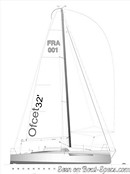
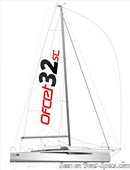



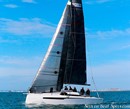
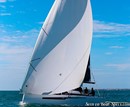
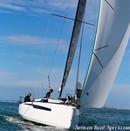
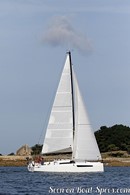



Ofcet 32 interior and accommodations - - 12/16
Picture extracted from the commercial documentation © Ofcet
Picture extracted from the commercial documentation © Ofcet


Ofcet 32 interior and accommodations - - 13/16
Picture extracted from the commercial documentation © Ofcet
Picture extracted from the commercial documentation © Ofcet


Ofcet 32 interior and accommodations - - 14/16
Picture extracted from the commercial documentation © Ofcet
Picture extracted from the commercial documentation © Ofcet
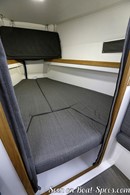

Ofcet 32 interior and accommodations - - 15/16
Picture extracted from the commercial documentation © Ofcet
Picture extracted from the commercial documentation © Ofcet
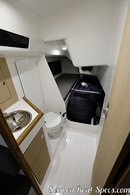

Ofcet 32 interior and accommodations - - 16/16
Picture extracted from the commercial documentation © Ofcet
Picture extracted from the commercial documentation © Ofcet
Similar sailboats that may interest you:
Sailboats
First built hull
Hull length
2003
33’ 2”10.11 m
2016
31’ 8”9.65 m
2017
32’9.75 m
2017
40’12.2 m
2016
32’ 2”9.8 m
2015
29’ 1”8.88 m
2019
30’9.14 m
2015
29’ 1”8.88 m
2013
29’ 2”8.9 m
2013
30’9.14 m
2009
30’ 4”9.25 m
2009
32’ 10”9.99 m
1997
31’ 2”9.5 m
2015
35’ 1”10.69 m
2012
37’ 4”11.38 m